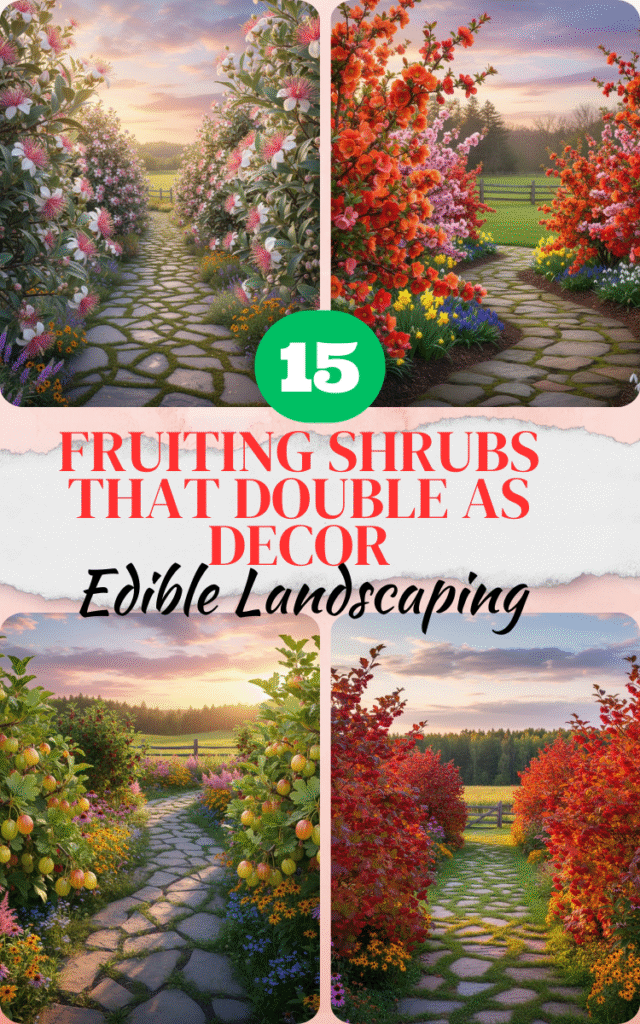
For years, I treated my garden like a museum—a place where beautiful things were displayed but rarely touched. I had manicured hedges, striking specimen trees, and colorful perennial borders, all strictly ornamental. But honestly, I started realizing I was missing a massive opportunity. Why dedicate so much space and effort just for show when that same effort could yield a continuous harvest? That’s the core idea behind edible landscaping, and trust me, it’s not about giving up beauty for those messy, brown rows of vegetables. It’s about merging them seamlessly.
This isn’t just gardening; it’s maximizing every square foot of outdoor space. Many people believe that food-producing plants are too scraggly, require too much maintenance, or simply aren’t refined enough for a formal landscape. I want to shatter that myth. By using specific shrubs that have been selected not just for their fruit but for their form, texture, and color, we can create a landscape that is both stunningly beautiful and incredibly productive.
If you’re ready to stop choosing between eye candy and snacks, you’ve come to the right place. I’ve compiled a list of 15 versatile and resilient fruiting shrubs, the true “Fruiting Ornamentals.” These plants are so visually appealing they are perfect for hedges, borders, and specimen plantings, and your neighbors will never guess they’re also your personal grocery store, providing delicious, accessible harvests across all four seasons.
The Architectural & Four-Season Beauties (Ornamental Focus)
These shrubs offer exceptional beauty, often serving as the garden’s focal point before the fruit even appears.
1. Serviceberry (Amelanchier spp.)
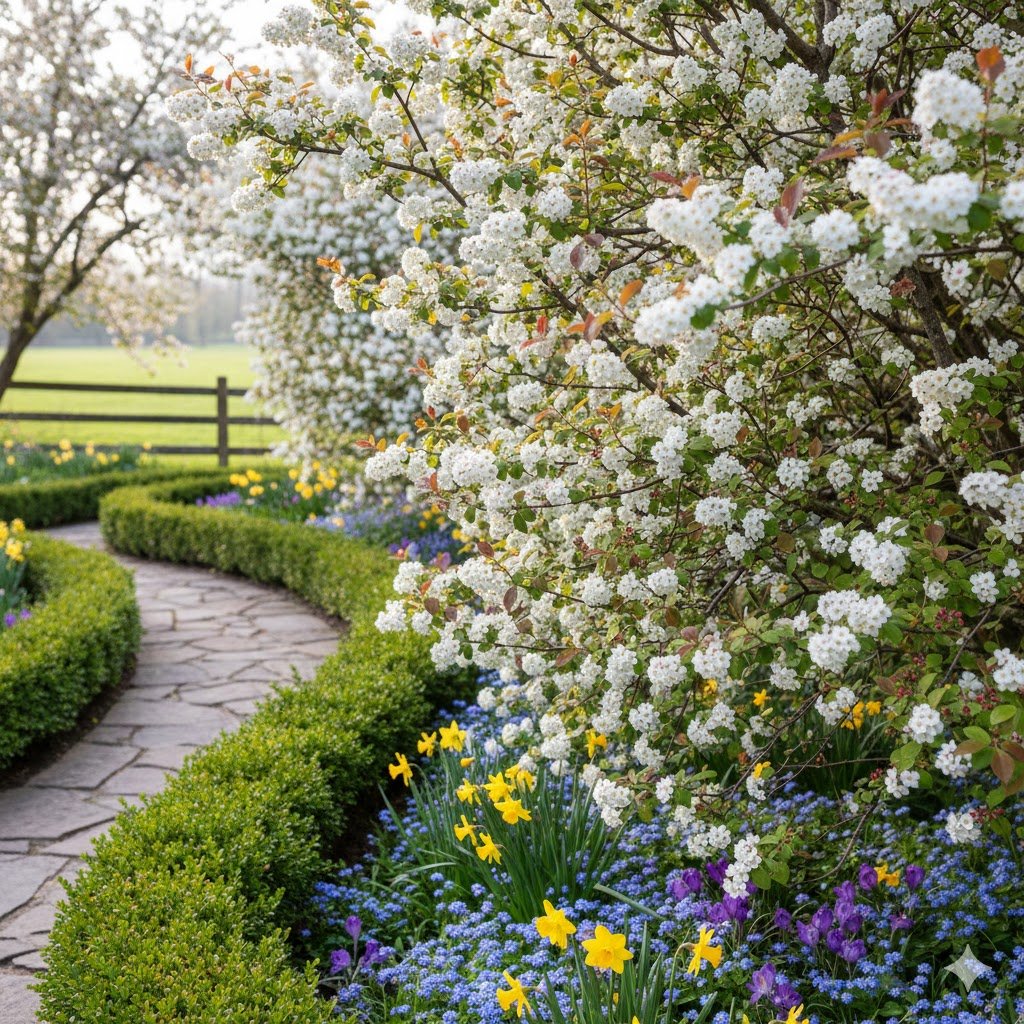
If I had to pick a single plant that perfectly embodies the edible ornamental ideal, it would be the Serviceberry. It’s truly a multi-season stunner, starting the year with a delicate puff of white, airy flowers in early spring—sometimes even before the leaves fully emerge. This beautiful floral cloud provides light, vertical structure in the landscape, often serving as an elegant alternative to the ubiquitous Crape Myrtle or Japanese Maple.
Following the showy blooms, the shrub (or small tree, depending on how you train it) develops clean, blue-green summer foliage. Hidden among those leaves are the berries, which look and taste uncannily like a blueberry but often ripen earlier in the season. They are absolutely delicious fresh, but I find they make the most fantastic pies and muffins, justifying the brief rush to beat the birds to the harvest.
But the spectacle isn’t over when the harvest wraps up. As autumn arrives, the Serviceberry explodes into a breathtaking display of orange, copper, and fiery red hues. Whether you choose a large multi-stemmed shrub for the corner of your yard or a single-trunk specimen tree to anchor a border, this plant provides structure, flowers, summer shade, fruit, and dramatic fall color, making it worth every inch of space.
2. Elderberry (Sambucus spp.)
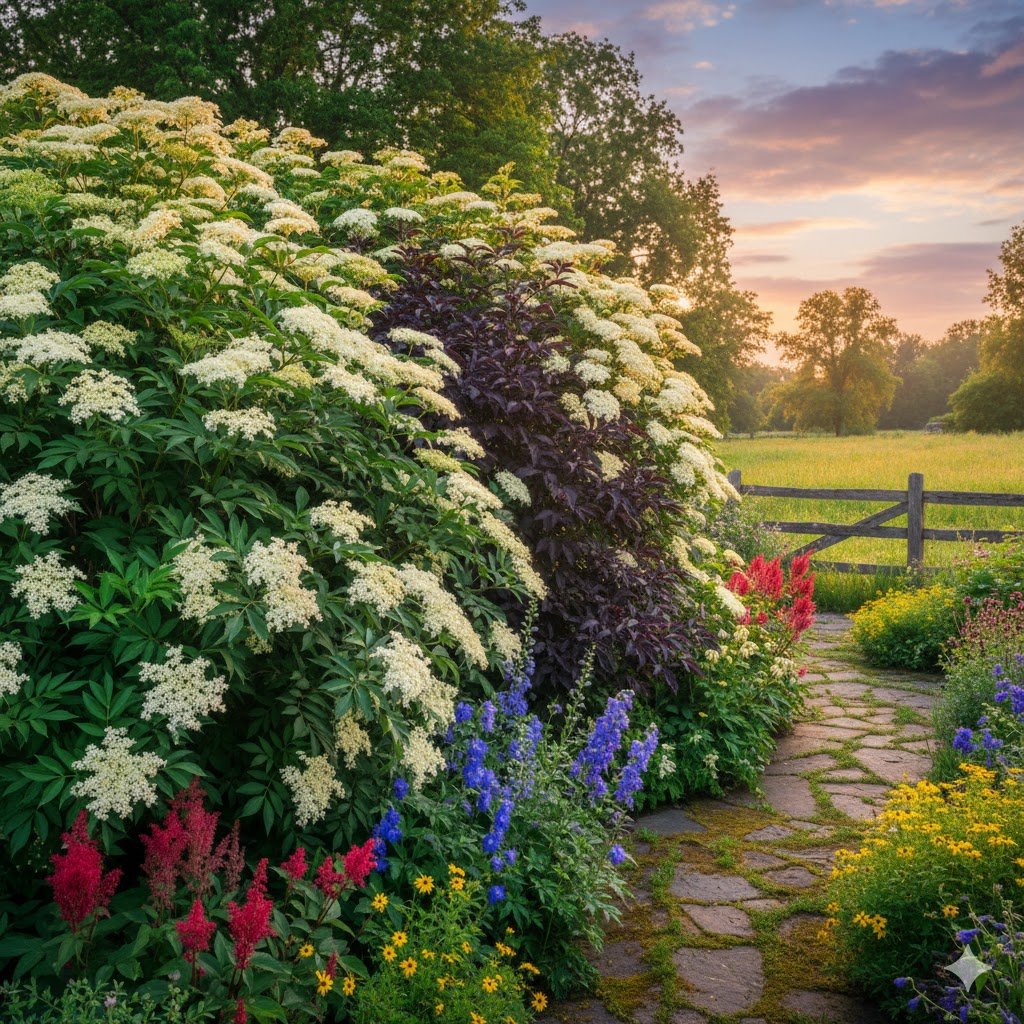
Elderberry is all about drama and scale, and I love using it when I need to quickly establish a bold, architectural screen or hedge. The foliage is lush and dark, creating a dense backdrop for flashier, smaller plants. In mid-summer, this plant becomes a showstopper when huge, flat-topped flower heads, known as umbels, bloom. These creamy white flowers practically perfume the entire garden with a sweet, musky scent, announcing their presence beautifully.
The harvest is unique because you get two distinct crops. First, the flowers themselves are used to make light, floral elderflower cordial or even dipped in batter for fritters. If you leave the flowers, they transform into impressive clusters of deep purple-black berries. I primarily use the berries for making deeply colored, medicinal syrups and jams, ensuring I have a stock of antioxidant-rich treats for the winter months.
While Elderberry is rugged and easy to grow, it does benefit from being pruned hard to the ground every few years to manage its size and encourage fresh, robust canes. This aggressive pruning helps maintain its desirable, bold shape and keeps it looking fresh rather than leggy. When the fruit clusters are ripening, they hang so dramatically against the dark foliage that they are, in themselves, a major decorative element.
3. Cornelian Cherry (Cornus mas)
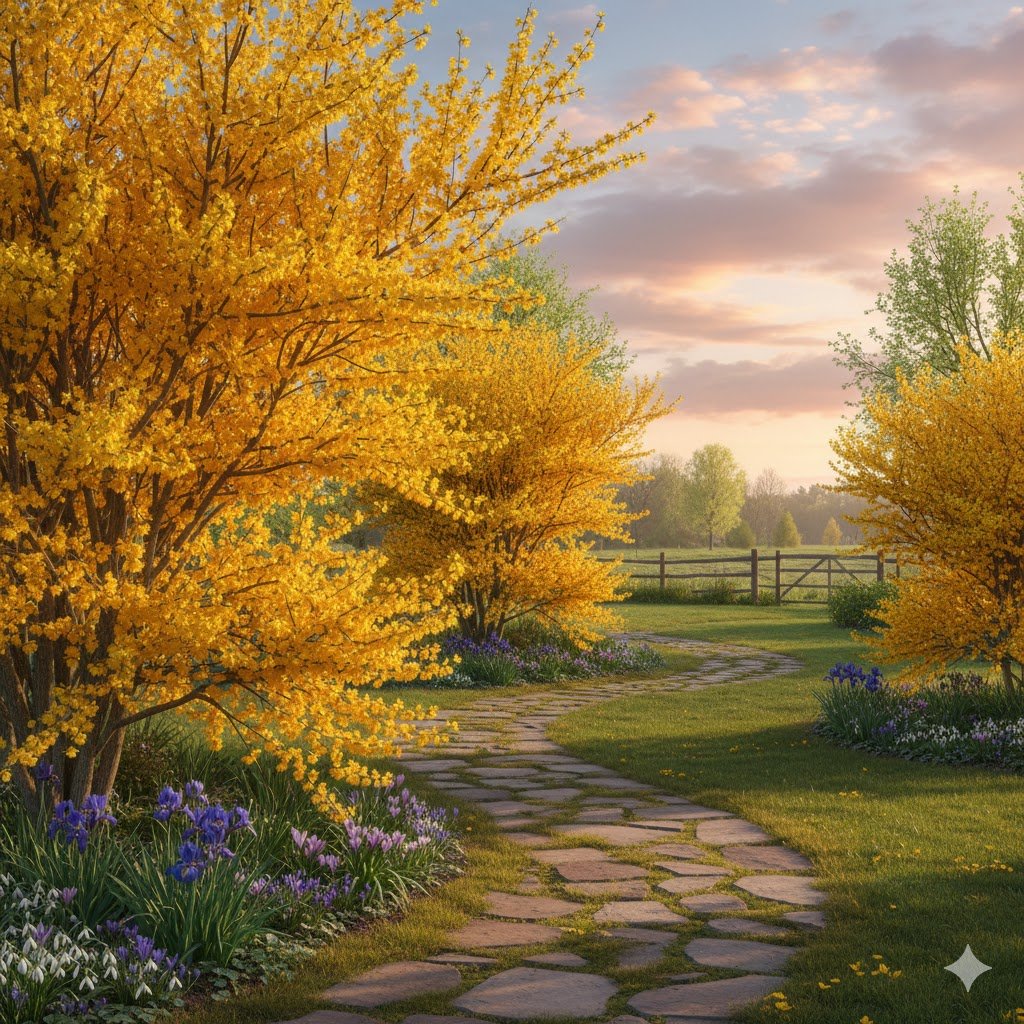
When the garden is still gray and sleeping, the Cornelian Cherry is already wide awake. This is one of the very first shrubs to flower, sometimes appearing as early as late February or early March, depending on your climate. It doesn’t put on a splashy show of large petals, but rather a charming, fine cloud of tiny, bright yellow flowers covering the bare branches—a true sign that spring is on its way, regardless of the calendar.
Don’t let the name fool you; this isn’t a true cherry, but the fruit that ripens in mid-summer is strikingly similar in appearance, though far more tart. The bright red, oblong fruits are fantastic for preserves, syrups, or even being infused into vodka or brandy for a unique liqueur. Harvesting is easy because they tend to drop when fully ripe, making it simple to lay a tarp underneath and shake the branches.
Beyond the spring flowers, the Cornelian Cherry provides excellent winter interest thanks to its exfoliating, textured bark. Even when completely bare, the dappled, rugged surface adds a structural layer to the winter landscape. It’s a low-maintenance, multi-purpose shrub that asks for little but gives back beautiful blooms and a uniquely flavorful fruit in a tidy, manageable size.
4. Aronia Berry (Chokeberry)

Aronia is the powerhouse of the edible world, famed for its incredibly high antioxidant content. The berries themselves are extremely tart—hence the nickname “Chokeberry”—which means they are best blended into smoothies, mixed with sweeter fruits in jams, or dried and used as a potent trail mix ingredient. If you want a functional food that fights back against winter colds, this is a must-plant.
However, Aronia doesn’t just earn its keep in the kitchen; it’s one of the best choices for ornamental landscaping because of its foliage. Throughout the summer, it holds a clean, glossy, dark green leaf that looks polished and healthy, providing a reliable green backdrop. The neat, mounding habit makes it perfect for filling out ornamental borders or creating a low, tidy hedge along a pathway.
The true spectacle comes in the autumn. As soon as the temperatures dip, the Aronia leaves ignite, turning a brilliant, fiery mix of deep reds, purples, and scarlets that rival the spectacle of a maple tree. This explosion of color, combined with the clusters of dark purple berries still clinging to the branches, ensures it provides visual interest from its spring flower all the way into late winter.
5. Dwarf Quince (Chaenomeles spp.)

The Dwarf Quince is a statement piece in the spring garden, often used because of its dramatic, showy flowers. These blossoms—available in striking reds, vibrant pinks, or pure whites—bloom on bare, often thorny, wood well before most other shrubs dare to show color. This early, intense floral display makes it a phenomenal specimen planting or a brilliant contrast piece against evergreen backdrops that are still asleep.
While the flowers are stunning, the fruit is the hidden gem. It’s large, round, and highly fragrant, filling the air with a sweet, citrus-like perfume as it ripens. The fruit is hard and extremely tart when raw, making it unsuitable for fresh eating, but its high pectin content and strong flavor make it invaluable for preserves, jellies, and baking where you need a tart counterpoint to sugar.
The shrub’s naturally sprawling, sometimes thorny habit makes it an excellent choice for a functional barrier or an impenetrable informal hedge. Its structure is rugged and interesting even after the leaves drop. I love placing one near a walkway simply to catch that unique fragrance when the fruits are beginning to mature in the late summer and early fall.
The Berry Workhorses (High Yield & Great Hedges)
These are the productive classics, but chosen for specific varieties that enhance landscape appeal.
6. Highbush Blueberry (Vaccinium corymbosum)

There’s simply no beating the taste of a handful of homegrown blueberries, warm from the sun. While they’re technically a classic edible, the specific varieties of Highbush Blueberry we choose today are far more than just fruit factories. These shrubs are incredibly productive, and planning for a mix of early, mid, and late season varieties ensures a steady supply for snacking, baking, and freezing throughout the summer.
The beauty of the blueberry starts in the spring with delicate clusters of bell-shaped flowers, ranging from pure white to a pale pink blush. The compact, upright habit is easy to manage and looks fantastic when planted in mass alongside other acid-loving plants like azaleas and rhododendrons. This grouping creates a visually cohesive and beautiful ornamental border while simplifying your soil amendments.
The Highbush Blueberry saves its biggest decorative punch for the cold weather. As summer fades, the deep green leaves turn a kaleidoscope of fiery red, orange, and even purple—a fall show that truly rivals any ornamental maple. When the leaves finally drop, the woody stems often have an attractive reddish tint, adding valuable color and texture to the otherwise monochrome winter garden.
7. Red Currant (Ribes rubrum)

Currants are the definition of an ornamental edible because of how the fruit is presented. Instead of being hidden away by leaves, the bright, translucent red berries hang in beautiful, elegant, dripping racemes, or strings, all along the branches. It’s a stunning effect, making the shrub look like it’s been decorated with tiny, edible jewels right before harvest.
The flavor profile is intensely tart and bright, which is why they are often overlooked for fresh eating unless you have a high tolerance for pucker. However, that high acidity makes them a spectacular ingredient for balancing sweetness in baking, or for making a beautiful, clear jelly that has that perfect tangy counterpoint. The sheer visual impact of the fruit makes the effort worthwhile, even if you only use them for garnish.
Red Currants have glossy, deeply lobed green leaves that give the shrub a structured, full appearance. They tolerate light shade very well and are often used as understory plants, but I find they work best as a low, manageable hedge. Since they fruit on older wood, the pruning regime is straightforward, allowing you to easily maintain a tidy, attractive form year after year.
8. Nanking Cherry (Prunus tomentosa)
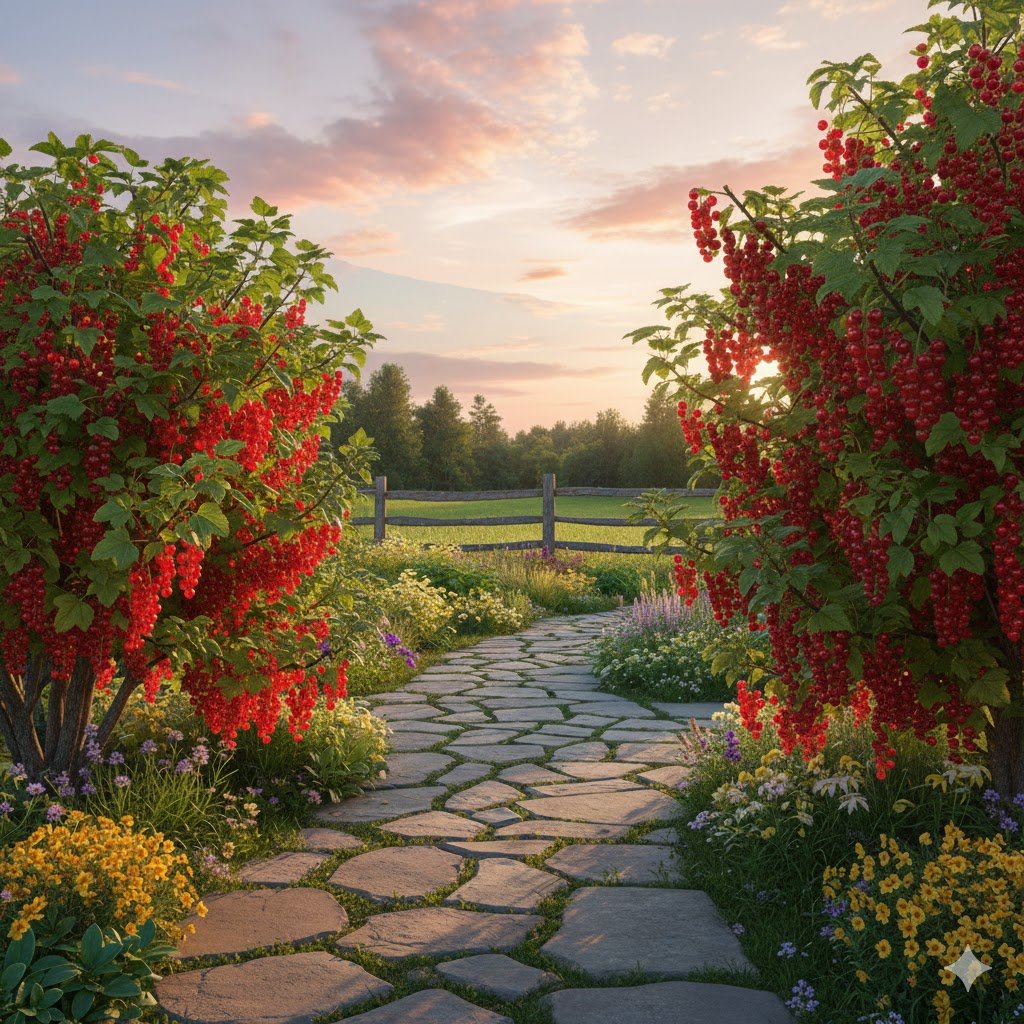
Nanking Cherry is another early season bloomer that gives you serious bang for your buck in the spring. Before the leaves are fully out, the entire shrub is covered in a dense froth of profuse, slightly pinkish-white blossoms. This early, intense floral display makes it a highly desirable background shrub for mixed borders or when used as a fast-growing, dense privacy screen, providing immediate texture.
I particularly appreciate the Nanking Cherry’s dense, low-branching habit; it naturally creates a full, bushy form from the ground up, making it excellent for screening or as a specimen shrub that provides solid coverage. It doesn’t get as large or as messy as many ornamental cherries, which makes it far more manageable in average-sized gardens where space is a premium.
The harvest begins relatively early, with small, tart cherries that are perfect for eating fresh if you enjoy a little zing, or excellent for making juice and jams. Because they ripen so early, they provide a much-needed fruit fix before the traditional summer berries are even close to being ready. It’s an easy-to-grow, highly adaptable shrub that provides visual appeal through density and flowers, and a welcome early harvest.
9. Goji Berry (Lycium barbarum)
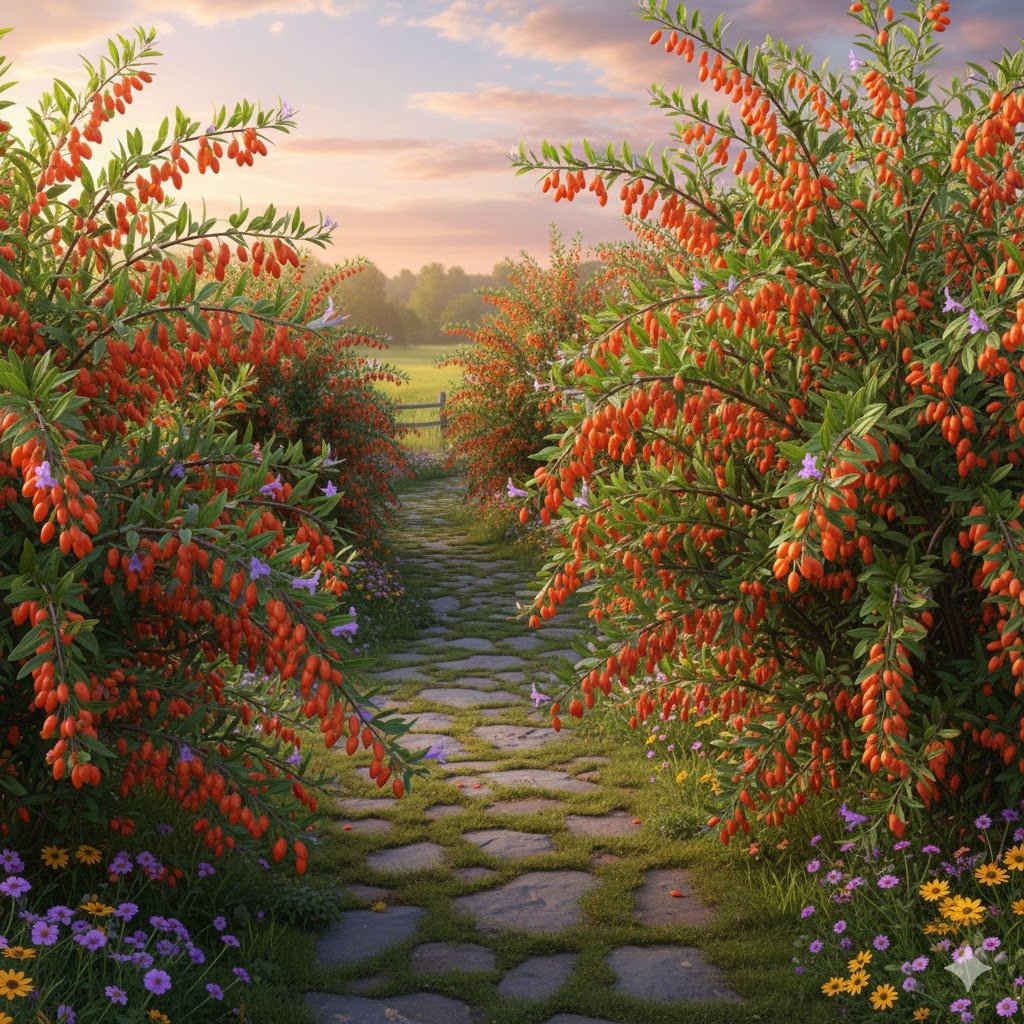
The Goji Berry is perhaps the most unconventional choice on this list due to its habit, but its long, arching, almost fountain-like growth habit is quite attractive when properly trained. It has delicate, slender leaves and produces small, charming lavender flowers throughout the growing season, giving it a light, airy texture that contrasts well with denser plants.
The orange-red berries are often touted as a “superfood,” and while I can’t vouch for their mythical properties, they are certainly a fun and interesting crop to grow. They can be eaten fresh, though their flavor is mild and slightly sweet, or more often dried to be added to cereal, teas, or trail mixes. The small, bright red berries cling beautifully to the stems, providing striking visual interest.
Because of its vigorous, sometimes sprawling nature, the Goji Berry requires annual pruning and training to look tidy and decorative. If left untamed, it can look a bit wild, but if you take the time to espalier it or guide it up a formal structure, the resulting fountain of greenery and red berries can be a spectacular garden focal point that utilizes vertical space.
10. Pineapple Guava (Feijoa sellowiana)

For those in warmer climates (Zone 8+), the Pineapple Guava is a must-have for its sheer ornamental quality. I love its striking silver-green, slightly fuzzy foliage, which provides a cooling, dusty contrast against the deep greens of other garden plants. It has a beautiful, rounded shape and can be easily clipped into a dense, attractive hedge that holds its leaves year-round in mild areas.
The flowers are truly unique and gorgeous—a mix of fleshy, white petals surrounding a dramatic burst of crimson stamens. They look almost tropical and are themselves edible; the petals are sweet and have a fun, chewy texture, making them a fantastic, unexpected addition to salads. This floral show alone is worth planting the shrub, even if you never harvested the fruit.
The fragrant, oval fruit usually ripens in the fall and has a complex, tart flavor often described as a mix of pineapple, apple, and mint. It’s usually enjoyed by slicing it in half and scooping out the pulp. When massed as a hedge, the shrubs offer solid structure and a uniform texture, making the Pineapple Guava an ideal choice for a functional and beautiful living fence.
Dwarf, Compact & Unique Forms
Ideal for small spaces, containers, and foundation plantings where neatness is a must.
11. Dwarf Honeyberry (Lonicera caerulea, a type of edible honeysuckle)
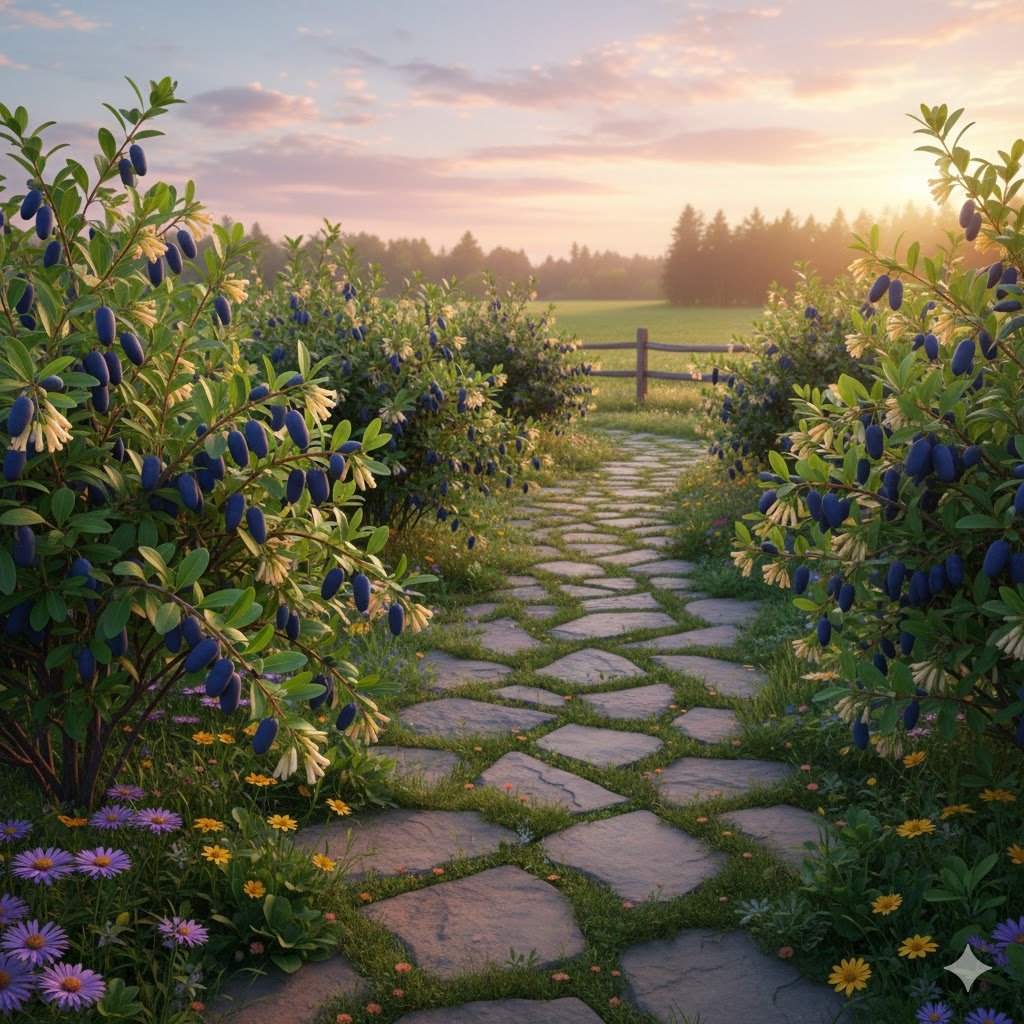
The Honeyberry is an absolute champion for gardeners in cold climates or those with small spaces, as it’s incredibly cold-hardy and maintains a neat, compact structure. I appreciate that it naturally grows into a tidy, mounding shrub that often mimics the shape and density of ornamental boxwood or yews, fitting perfectly into formal or small-space foundation plantings where a clean line is essential.
The berries, which are elongated and blue, are often called “Haskaps” and are another one of those essential early season harvests. They taste like a tangy cross between a raspberry and a blueberry, providing a welcome burst of flavor months before the traditional summer berries ripen. Remember, you usually need at least two different varieties planted together for successful pollination and fruit set.
While the flowers are somewhat inconspicuous, the clean foliage and the extremely neat habit make this shrub a reliable performer in any decorative setting. If you are looking to replace a boring, non-fruiting hedge with something both functional and attractive that can handle harsh winters, the Dwarf Honeyberry is your answer, providing year-round structure and early summer fruit.
12. Dwarf Raspberry (Rubus idaeus ‘Raspberry Shortcake’)
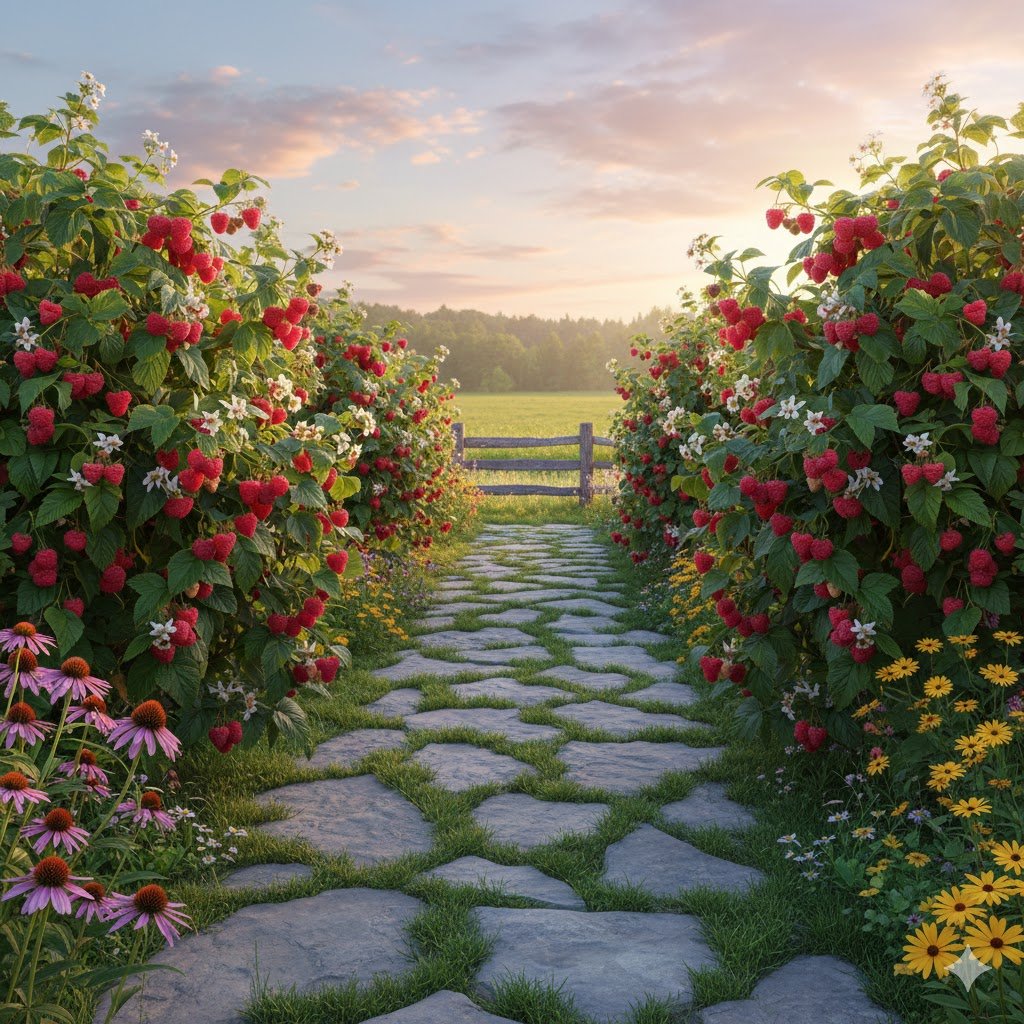
Traditional raspberries are notorious for being aggressive spreaders, often taking over garden beds with thorny, unruly canes. This is why I love the new, truly dwarf, thornless varieties like ‘Raspberry Shortcake.’ They eliminate the mess and the pain, making it possible to integrate raspberries into high-traffic areas and ornamental beds without worry.
These compact shrubs rarely exceed three feet in height and maintain a beautiful, rounded shape naturally, without needing heavy pruning. This makes them perfect for patio containers, where their mounding form looks highly decorative. Placing them at the front of a perennial border also works wonderfully, providing a neat layer that requires virtually no intervention.
The best part is that you don’t sacrifice flavor or yield for size. They still produce standard, sweet, delicious raspberries, ready for snacking right off the branch, making them ideal for kids’ gardens. It is a true testament to modern breeding, allowing even balcony gardeners to enjoy a beautiful ornamental plant that produces a substantial and easy-to-reach harvest.
13. Cranberry Bush (Viburnum trilobum)

The Cranberry Bush, a type of native Viburnum, is a classic ornamental that happens to be edible. Its spring show is spectacular, featuring large, flat-topped lace-cap flowers or the classic snowball varieties of creamy white blossoms. This is followed by one of the most brilliant fall foliage displays, with leaves turning intensely scarlet and crimson across the entire shrub.
Its greatest decorative asset, however, is its persistent winter fruit. Bright red berry clusters cling tightly to the branches, providing essential pops of color against the white snow or gray winter sky long after the leaves have dropped. This makes it invaluable for providing structure and cheer in the coldest months, and the berries are also a source of food for birds.
Though they are very tart, the berries are fully edible and can be used to make sauces and jelly, much like the commercial cranberry. The abundance of fruit combined with the incredible four-season visual interest—spring flowers, summer foliage, blazing fall color, and persistent winter berries—makes this shrub a decorative powerhouse in any yard.
14. Dwarf Mulberry (Morus nigra ‘Dwarf’)

I’ve often shied away from full-sized mulberry trees because they can grow into a messy, sprawling canopy that drops staining fruit everywhere. The Dwarf Mulberry varieties solve this problem beautifully. They maintain a naturally smaller size with a tidy, often weeping or rounded habit, allowing them to be incorporated into borders and defined spaces without dominating the garden.
The leaves of the Dwarf Mulberry are large, deeply lobed, and incredibly attractive, giving the shrub a lush, almost tropical look throughout the summer. Crucially, they hold their leaves late into the season, maintaining structure and coverage when other deciduous shrubs are already bare, extending the ornamental value well into late autumn when the garden often needs it most.
The best part is the extended harvest season. Unlike most berries that ripen all at once, mulberries produce sweet, dark, abundant berries continuously over a long period. This means endless snacking without the pressure of a massive one-time harvest. It’s a wonderful, manageable shrub that finally allows us to enjoy the sweetness of mulberry without the landscape chaos.
15. Gooseberry (Ribes uva-crispa)
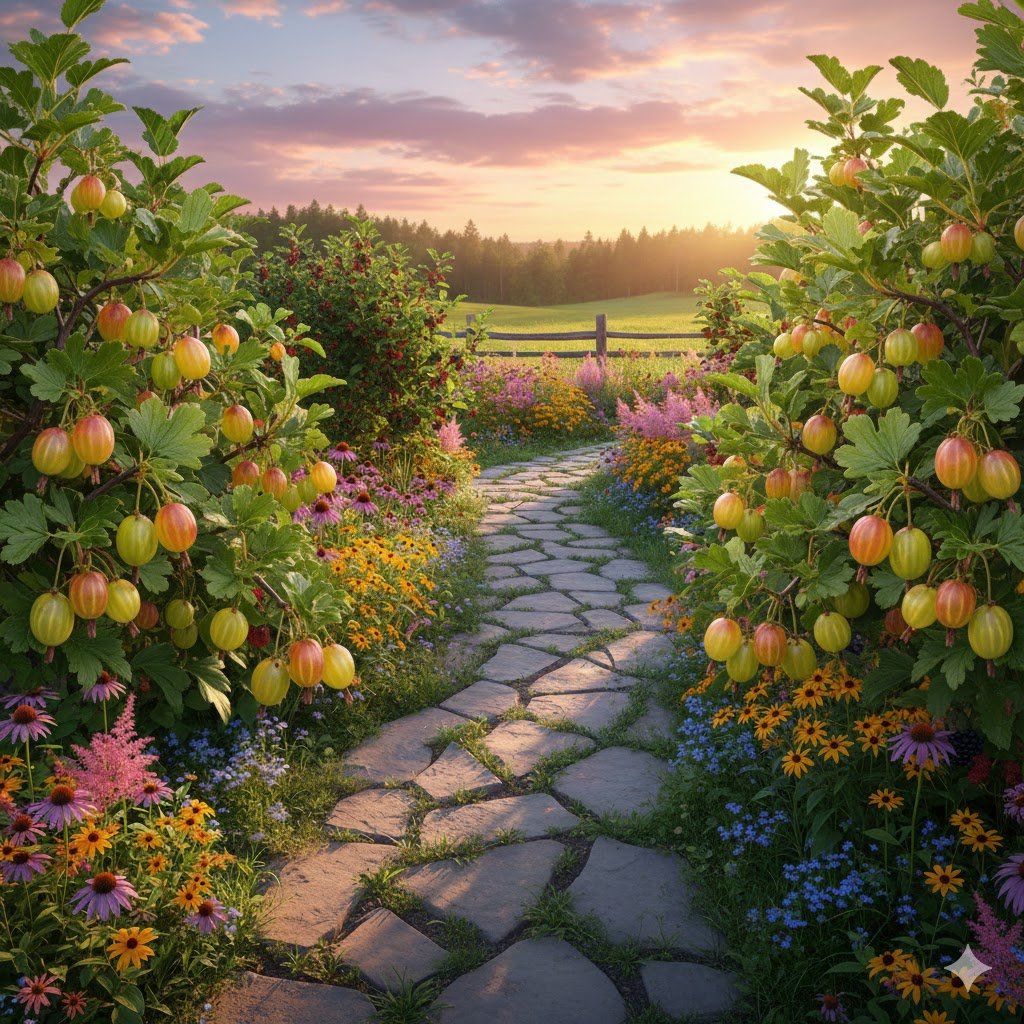
For those who love a formal, European garden aesthetic, the Gooseberry offers a unique training opportunity. Its small, structured habit lends itself perfectly to being trained into a formal “cordon” (single-stemmed column) or a standard tree form (Groseillier sur tige). This highly managed, geometric form makes it a perfect, unique accent for formal vegetable patches or decorative potager gardens.
The fruit itself is large, juicy, and highly versatile, with colors ranging from green and yellow to deep red and purple. I enjoy them raw when fully ripe, but they truly shine when used in crumbles, pies, and the classic English Gooseberry Fool, where their distinct flavor profile elevates the dish. They offer a tart, distinct flavor that is a welcome change from the typical summer berries.
Because of their neat, somewhat boxy structure, gooseberries are excellent for edging borders or pathways, adding a tidy layer that also produces food. While they do have thorns (look for thornless varieties if this is a concern), their highly attractive, bright green foliage and the beautifully colored fruit make them an outstanding decorative shrub that doubles as a classic garden harvest.
How to Integrate Edible Shrubs into Your Design
A. Planting for Aesthetics
When integrating these shrubs, I always begin by identifying the role I need the plant to fill visually, treating them as structural elements first. For instance, the Serviceberry, with its beautiful bark and upright habit, is a natural specimen tree and should be placed where it can anchor a view or shade a patio. Similarly, you can use the dramatic fall color of Aronia or Blueberry varieties to form a low, striking hedge that defines the edge of your property.
If your style leans toward formal or geometric gardens, training is key, and the Gooseberry is your best friend. By pruning them into cordons or standards, you can create symmetry and formal accents flanking an entryway or spaced regularly within a geometric planting bed, instantly elevating their ornamental status far beyond a simple bush.
Finally, think beyond just the flowers and fruit; focus on foliage texture and color contrast. The silver-green of Pineapple Guava looks incredible against the dark green backdrop of an Elderberry. By placing plants with contrasting textures and colors side-by-side, you ensure the garden looks rich and appealing even during the non-fruiting months, fulfilling their dual purpose effectively.
B. Maintenance for Dual Purpose
Pruning is where the dual-purpose challenge truly lies, as you need to maintain an attractive shape while encouraging fruit production. For many plants like Elderberry, this means pruning for renewal—removing the oldest, least productive canes to encourage the fresh, vigorous growth that produces the best fruit and keeps the shrub looking architectural and clean.
Conversely, shrubs like Dwarf Mulberry or Dwarf Quince might need shaping—light heading cuts to maintain a rounded, tidy form for decorative purposes. I always try to combine these tasks, making my aesthetic shaping cuts immediately after the main harvest is complete, ensuring I don’t remove wood that would have held next year’s fruit. The timing is everything to maximize both form and yield.
Lastly, don’t overlook fertilization. Fruiting plants are hungry, and neglecting their needs results in sparse fruit and weak, visually unappealing growth. A beautiful shrub is a healthy shrub. By ensuring you feed them appropriately (often an organic, slow-release fertilizer in early spring), you guarantee vigorous foliage and flower set, which in turn leads to a substantial, gorgeous harvest.
C. The Harvest & Wildlife
When designing your layout, remember that you actually have to get to the fruit! I like to ensure easy access to berries like Currants and Raspberries by placing them along paths or edges. This makes the act of harvesting pleasurable, not a frustrating battle against thorns or deep undergrowth, and encourages frequent picking.
Speaking of wildlife, you must accept what I call the “bird tax” on certain fruits, especially Serviceberries and Blueberries, which birds adore. Your choice is either to share or to protect. If you want a full harvest, you need to have fine mesh netting ready to throw over the shrubs just as the berries begin to change color. Otherwise, you can simply enjoy the added wildlife activity in your yard as they feast.
The presence of fruit-bearing shrubs also attracts a wide variety of beneficial insects and pollinators, which is another beautiful function they perform. By planning for the entire lifecycle—from spring flower to autumn leaf fall and winter structure—you ensure your shrubs are contributing beauty and utility to the garden every single day of the year.
Wrap Up
If your current garden design feels like it’s missing a compelling purpose, edible landscaping is the missing ingredient you need. These 15 fruiting shrubs are definitive proof that the most beautiful plants can also be the most productive. I challenge you to look at your borders, hedges, and foundation plantings and ask: Could this be giving me more? Start swapping out the purely ornamental for the functional and discover the satisfying pleasure of harvesting beauty right outside your door.

